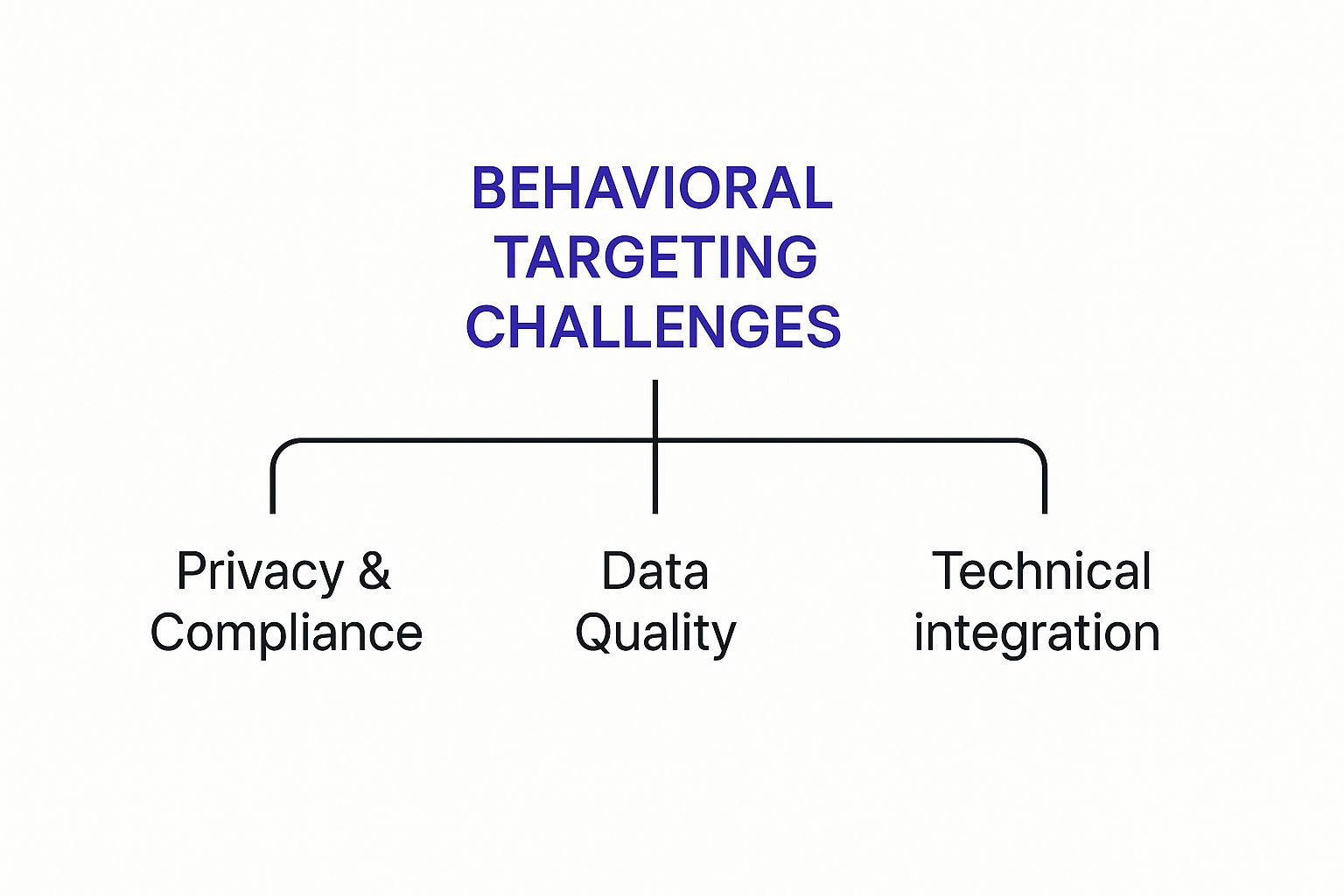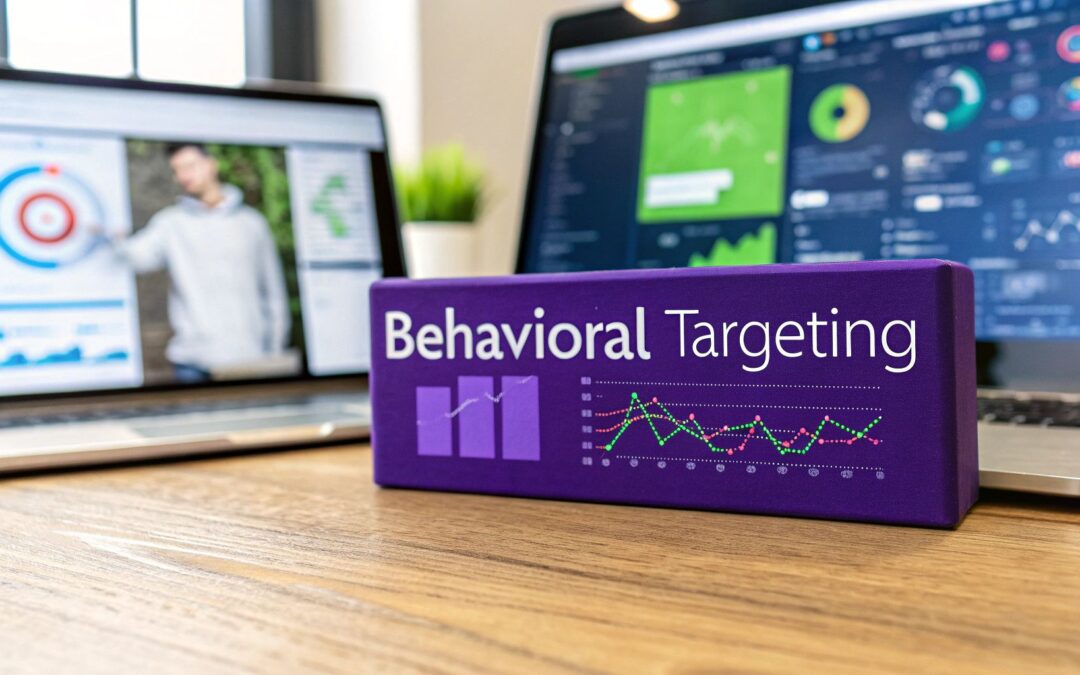Ever searched for something online, say, a new pair of hiking boots, and then suddenly started seeing ads for outdoor gear everywhere you go? That's behavioral targeting in action.
At its core, it's a way of showing people ads and content based on what they do online, not just who they are. It’s all about tracking actions—the digital breadcrumbs we leave behind as we browse the web.
So, How Does It Actually Work?
Think of it like this: you walk into your favorite local bookstore. The owner knows you’re a big fan of science fiction, so instead of pointing you to the new cookbook, they recommend a new sci-fi author they think you'll love.
Behavioral targeting does the exact same thing, just digitally. It uses technology to observe your anonymous browsing habits to create a more relevant and helpful online experience.
This process keeps an eye on a variety of user interactions across different websites and apps. These digital signals, or "behaviors," paint a picture of your interests and what you might be looking for. Common behaviors include:
- Pages Visited: The specific articles, products, or services you look at.
- Clicks: Which links, buttons, or ads you decide to click on.
- Search History: What you type into Google or a website's own search bar.
- Purchase History: What you've bought in the past or even just added to a shopping cart.
- Time on Page: How long you stick around to read or watch something.
Building a Digital Profile
Every click, search, and page view contributes to an anonymous profile—a kind of "digital footprint." This isn't linked to your name or personal email. Instead, it’s tied to a unique ID stored in a small file on your browser called a cookie. This data allows companies to group users with similar behaviors into audiences or segments.
For example, if you spend your lunch break browsing travel blogs, searching for flights to Italy, and reading reviews for hotels in Rome, you'll likely be grouped into a segment of users "planning an Italian vacation." The next thing you know, you’re seeing ads for pasta-making classes in Tuscany, not lawnmowers.
The core idea is brilliantly simple: show people things they’ve already shown an interest in. It’s a huge leap from the old spray-and-pray method where everyone saw the same ad, whether they needed it or not.
To make this clearer, let's break down the main parts that make behavioral targeting work.
Key Components of Behavioral Targeting
This table gives a quick summary of the essential elements involved in the behavioral targeting process and their respective functions.
| Component | Function | Example |
|---|---|---|
| Data Collection | Gathers anonymous information about user actions on websites and apps. | Tracking which product pages a user visits on an e-commerce site. |
| User Segmentation | Groups users with similar behaviors into distinct audiences. | Creating a "car enthusiast" segment for users who read auto blogs. |
| Content Personalization | Delivers targeted ads or content based on the user's segment. | Showing a member of the "car enthusiast" segment an ad for new tires. |
| Analysis & Optimization | Measures campaign performance to refine targeting strategies over time. | Analyzing click-through rates to see which ad creative works best. |
As you can see, it's a cyclical process of gathering data, grouping users, delivering relevant content, and then refining the approach based on what works.
It's All About Being Relevant
When you boil it all down, what is behavioral targeting really trying to achieve? It's about making the internet more useful for everyone.
For us as users, it means less noise. We see ads and content that are actually helpful or interesting, rather than a constant barrage of irrelevant messages. For businesses, it means their marketing dollars go further. They can focus their budget on people who are genuinely interested, which leads to better engagement, more sales, and a healthier return on their investment.
Essentially, it turns the internet from a giant, impersonal billboard into a helpful personal shopper.
How Data Collection and Analysis Works

To really get what behavioral targeting is all about, we need to pop the hood and see how it actually works. It's a quiet, behind-the-scenes process that's constantly watching user actions and turning that raw behavior into smart marketing decisions.
So, how does it all start? With two tiny but powerful pieces of tech: cookies and tracking pixels.
Think of cookies like digital nametags. When you land on a website, it sticks a small text file on your browser with an anonymous ID. This little tag helps the site remember what you did—the items you added to your cart, the pages you looked at, that sort of thing. It’s all about recall.
Tracking pixels are a bit different. They’re tiny, invisible images tucked into websites and emails. When that pixel loads, it pings a server, letting it know you've visited a page or opened an email. Together, cookies and pixels collect the "digital breadcrumbs" that lay the groundwork for everything that follows.
What Kind of Data Is Collected
The whole point of gathering this data is to paint a detailed—but anonymous—picture of a user’s interests. It’s not about finding out your name or address; it’s about understanding what you like based on your actions. The data is purely behavioral.
Here’s a look at the typical information that gets collected:
- Browsing History: Which websites you go to, the articles you read, and how long you spend on a page.
- Search Queries: The words you type into Google or a website's own search box.
- Engagement Metrics: The videos you watch, the links you click, and how far you scroll.
- Purchase Information: What you’ve bought in the past, items you left in your cart, and products you’ve recently browsed.
All this information gets bundled together to create a user profile. If your profile shows you’re constantly visiting tech review sites and searching for "best gaming laptops," you'll probably get tagged as a "tech enthusiast" or someone "in the market for a new computer."
Turning Data into Predictions
Collecting the data is one thing, but making sense of it is where the real work begins. Modern behavioral targeting leans heavily on machine learning and artificial intelligence (AI) to chew through massive amounts of information that no human could ever analyze on their own.
These algorithms are trained to find patterns. For example, an AI might notice that people who read articles about sustainable living are 75% more likely to buy eco-friendly home products within the next week. That’s the kind of predictive insight that makes this so powerful.
It's a shift from reactive to proactive marketing. Instead of just responding to what a user has done, systems can now predict what they are likely to do next and present a relevant offer at the perfect moment.
Ultimately, this whole analytical engine turns raw behavioral data into clearly defined audience segments. Someone who just bought a plane ticket is in a very different mindset from someone who is still comparing destinations. AI helps spot these subtle differences, allowing marketers to be incredibly precise with their targeting. It's how the right message finds the right person at just the right time, making for a better user experience and, of course, better results for the business.
Why Behavioral Targeting Drives Business Growth

It’s one thing to understand the how of behavioral targeting, but the real magic happens when you see the why. When you stop shouting your message to a generic crowd and start having a conversation with individual customers, the impact on your business becomes undeniable. It’s a shift that leads to tangible growth and a much healthier return on investment (ROI).
Essentially, you stop wasting your marketing budget on people who aren't interested. Instead, every dollar goes toward connecting with someone who has already raised their hand, showing they might want what you have to offer. That precision is what makes this strategy so powerful.
Maximizing Ad Spend and ROI
Imagine you run an online store that sells high-performance running shoes. The old way of doing things would be to run an ad targeting anyone with a vague interest in "fitness." But with behavioral targeting, you can get much smarter. You could show your ads only to people who have recently searched for "marathon training plans" or browsed other websites for running gear.
This sharpens your focus and slashes wasted ad spend. You’re no longer guessing; you’re making informed decisions based on a user’s actual behavior. The outcome is a much higher ROI because your marketing efforts hit the bullseye every time.
The core advantage is efficiency. Behavioral targeting ensures marketing messages are not just seen, but are seen by the right people at the moment they are most receptive to them.
The numbers back this up, too. Targeted digital ads consistently get better results. Research shows that well-executed campaigns can lift sales by over 10% and pull in roughly 2.7 times more revenue per ad than a generic, non-targeted approach.
Boosting Conversion Rates and Engagement
When the ads, popups, and offers people see on your site feel like they were made just for them, they're far more likely to take action. This isn't rocket science—it's just good communication. When you speak directly to someone's needs, the path from browsing to buying becomes incredibly smooth.
Think about someone who added a pair of sneakers to their cart but got distracted and left. A few hours later, they see a subtle ad for those exact shoes, maybe even with a small discount. That little nudge is often all it takes to bring them back and close the deal. This is a perfect example of how to improve website conversion rates by aligning your marketing with clear user intent.
But the benefits go beyond just a one-time sale. It creates a cycle of positive interactions:
- A Better User Experience: People appreciate seeing content that's relevant to them. Their time online feels more productive and less cluttered with ads they don't care about.
- Stronger Customer Connections: Personalization is a powerful way to show customers you're listening. It builds trust and fosters the kind of loyalty that keeps them coming back.
- More Engagement: When content resonates, people click, share, and comment. This signals to search engines and social platforms that your content is valuable, which helps even more people discover it.
A Look at Different Behavioral Targeting Methods
Think of behavioral targeting less as a single tactic and more like a well-stocked toolbox. Each tool is designed for a specific job, whether you want to win back a visitor who left or create a unique experience for someone who just landed on your site. The key is knowing which method to grab for the right situation.
Let's break down the main approaches.
Onsite Behavioral Targeting
The most direct method is onsite behavioral targeting. This one is all about what happens on your turf—your website. It tracks a user's clicks, the pages they visit, and how they interact with your content to customize their experience in real-time or on their next visit.
For example, an e-commerce store could use this to show a "Welcome Back!" popup with a special discount for a returning customer. Or, if someone spends a few minutes looking at hiking boots, the homepage banner could instantly shift to feature your newest outdoor gear the next time they stop by. It's all about making your own site feel more personal and responsive.
Retargeting: The Ads That Follow You Around
Next up is retargeting, a method you've almost certainly experienced firsthand. Ever looked at a product online, only to see ads for it popping up everywhere you go? That's retargeting in action. It uses cookies to display your ads on other websites and social media feeds after a person has left your site.
This is a powerful way to stay on a potential customer's radar and gently nudge them back. Someone who added a product to their cart but didn't check out might see an ad for that exact item while scrolling Instagram an hour later. It’s the digital equivalent of a friendly reminder. You can find more compelling behavioral targeting examples to see just how effective this can be.
Network-Level Targeting
Finally, we have network-level targeting, which zooms out to get the bigger picture. This strategy involves gathering anonymous data from a massive network of websites to build detailed user profiles. Ad networks like Google Ads are masters at this, learning about a user’s interests based on their browsing habits across thousands of different sites.
This allows advertisers to find entirely new audiences who haven't visited their site yet but have shown a clear interest in related topics. For instance, a company selling high-end coffee beans could target users who frequently read coffee blogs and watch barista tutorials on YouTube, even if they’ve never heard of the brand. It’s all about connecting with new people based on their broader digital footprint.
To help you decide which approach fits your needs, here's a quick comparison of these common methods.
Comparison of Behavioral Targeting Methods
| Targeting Type | Primary Use Case | Common Platforms |
|---|---|---|
| Onsite Targeting | Personalizing the user experience on your own website in real-time. | Website popups, dynamic content blocks, personalization plugins. |
| Retargeting | Re-engaging past visitors who left your site without converting. | Google Ads, Facebook Ads, LinkedIn Ads, dedicated retargeting platforms. |
| Network-Level | Acquiring new customers by reaching users with relevant interests. | Ad networks (e.g., Google Display Network), data management platforms (DMPs). |
Each of these strategies offers a unique way to connect with your audience, but they aren't without their challenges.
Of course, putting these strategies into practice isn't always a walk in the park. This diagram breaks down some of the most common hurdles businesses run into.

As the graphic shows, getting it right means carefully handling privacy rules, making sure your data is accurate, and dealing with the technical side of implementation.
Future Trends and the Global Market
Behavioral targeting isn't just some passing fad; it's a core part of how the digital economy works, and its influence is only getting stronger. As we all spend more of our lives online, the sheer volume of behavioral data being created is exploding. When you combine that flood of data with powerful new technologies, you get a market that's really starting to hit its stride.
The demand for smarter, more relevant advertising is attracting serious investment and pushing innovation forward. This is about more than just showing people better ads; it’s about creating the kind of personalized online experiences that customers have come to expect as standard.
The Forces Fueling Market Expansion
So, what's behind this massive growth? A few key things are pushing it along. The non-stop boom in e-commerce is a huge factor, as online stores depend on this data to suggest the right products and stop people from abandoning their shopping carts. At the same time, big leaps in artificial intelligence are allowing us to understand consumer behavior with frightening accuracy, turning mountains of raw data into sharp predictions.
These tech advances are making behavioral targeting easier to use and more effective for businesses of all shapes and sizes, cementing its place as a must-have marketing tool. The market's consistent upward climb tells you everything you need to know about its importance.
Grasping where the market is headed is vital. It’s not just about getting an edge today; it’s about being ready for what digital interaction will look like tomorrow. To stay in the game, you have to adapt to these powerful shifts.
The numbers really drive this point home. The global behavioral targeting market was valued at roughly USD 10.5 billion in 2023. By 2032, it's expected to blast off to around USD 29.8 billion. That’s a compound annual growth rate (CAGR) of about 12.5%, which is a clear signal of just how fast this space is expanding. You can dig into more details on this growth over at Data Insights Market.
What Lies Ahead for Behavioral Targeting
Looking into the crystal ball, the next chapter for behavioral targeting will be about delivering even more personalized experiences while carefully navigating the tricky landscape of user privacy. We can expect a few key trends to take center stage:
- Hyper-Personalization at Scale: Imagine AI adjusting website content and offers in real-time for every single user. This isn't science fiction anymore; it’s about creating a truly unique journey for each person who lands on your site.
- Integration with New Channels: This type of targeting is breaking out of the website and social media box. Soon, it'll be common on connected TVs, voice assistants, and all sorts of in-app experiences.
- Emphasis on First-Party Data: With third-party cookies on their way out, companies will have to get better at collecting and understanding data directly from their own customers. This means building stronger relationships based on trust and consent.
For anyone running a business, this means the tools and tactics for behavioral targeting are only going to get more sophisticated, opening up exciting new ways to connect with your audience in a way that truly resonates.
The Link Between Analytics and Targeting

Great targeting isn’t a happy accident—it’s driven by smart analysis. Think of behavioral analytics as the brains of your marketing, and targeting as the hands that carry out the plan. Analytics is all about gathering user data to figure out the why behind their actions. Targeting is simply what you do with that knowledge.
Trying to use behavioral targeting without solid analytics is like flying blind. It's just a shot in the dark. You might see what users are doing, but you won’t have a clue what their clicks are actually telling you. Analytics helps you piece together the entire customer journey, showing you exactly where people get stuck or lose interest.
This level of understanding is what lets you move past basic segmentation. Instead of just lumping people into a group like "viewed product X," you can build sophisticated audiences based on their unique and complex behaviors.
From Raw Data to Actionable Segments
The real magic of analytics is how it transforms a mountain of messy, raw data into clean, actionable segments. It’s the engine that helps you find your best, most valuable customer groups.
So, how does that actually work?
- Journey Mapping: Analytics tools trace the paths users take through your site, showing you which routes are popular and where people tend to leave.
- Pattern Recognition: Smart algorithms spot subtle trends you might miss, like noticing which types of blog posts get the most engagement.
- Segment Creation: Armed with these patterns, you can create incredibly specific audience segments, like "people who read three articles before checking the pricing page."
The whole point is to build a complete picture of what a user wants to achieve. Analytics gives you the context to make sure that when you finally show them a message, it’s not just relevant, but perfectly timed.
More advanced tools, like multi-touch attribution models, can give you an even richer understanding of the customer journey. Once you have these well-defined segments, you can hit them with compelling messaging using the right popup power words that convert.
This analytical foundation is at the heart of a booming industry. The behavioral analytics market, valued at USD 1.10 billion in 2024, is expected to explode to USD 10.80 billion by 2032. That massive growth shows just how crucial this kind of data interpretation has become for businesses. You can read more about this market growth on Fortune Business Insights.
Still Have Questions? Let's Clear a Few Things Up
As you get your head around behavioral targeting, a few questions always seem to pop up. Let's tackle them head-on so you can see how this all works in practice.
Isn't This Just Contextual Targeting?
It’s a common mix-up, but they’re actually two very different beasts.
Think of it this way: Contextual targeting is all about the environment. It places an ad for a new camera on a photography blog because the topic is relevant. The ad fits the page.
Behavioral targeting, on the other hand, is about the person. It shows that same camera ad to someone who’s been browsing camera reviews and online electronics stores, even if they’re currently reading a news article or a recipe for lasagna. The ad follows the user's interest, not the page's content.
What About User Privacy?
This is the big one, and for good reason. The key here is that behavioral targeting typically relies on anonymous data. It uses cookies and tracking pixels to build a profile of interests and behaviors, not a file with your name, address, or email in it.
Plus, with regulations like the GDPR in full swing, companies are required to get your consent before they start tracking you. They also have to give you a clear and easy way to opt out. It's a system designed to create a balance between relevant advertising and the fundamental right to privacy.
The goal is to understand interests, not identities. Effective targeting focuses on anonymous patterns of behavior to deliver relevance without crossing privacy lines, ensuring a better experience for everyone.
Is This Something Small Businesses Can Actually Use?
Absolutely! You don't need a massive marketing budget to get started. Platforms like Google Ads and Meta have democratized behavioral targeting, giving businesses of all sizes access to incredibly powerful tools.
These platforms let you build highly specific audiences based on what people are interested in and how they behave online. This means even a small shop can run incredibly efficient campaigns and get its message in front of the right people, leveling the playing field in a big way.
Ready to bring this level of smart targeting to your own Divi website? With Divimode's Divi Areas Pro, you can easily create popups, fly-ins, and other dynamic content that appears based on user actions, page visits, exit intent, and much more. Start building a smarter, more personalized website today at divimode.com.






